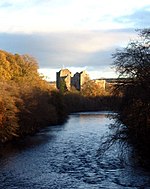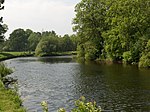Doune railway station
Beeching closures in ScotlandBuildings and structures demolished in 1968Disused railway stations in Stirling (council area)DouneFormer Caledonian Railway stations ... and 6 more
KilmadockPages with no open date in Infobox stationRailway stations in Great Britain closed in 1965Railway stations in Great Britain opened in 1858Scotland railway station stubsUse British English from January 2018

Doune was a railway station located in Doune, in the council area of Stirling, Scotland. The station was rebuilt in typical Caledonian Railway style in the early 1900s after the completion of the Callander and Oban Railway in 1880. It closed on 1 November 1965 and was demolished around 1968. The site was used by a timber merchant for many years. In the late 1990s a private housing estate was built on the station site. Although little or no trace of the station remains, the station house still stands at the entrance to the housing development.
Excerpt from the Wikipedia article Doune railway station (License: CC BY-SA 3.0, Authors, Images).Doune railway station
Station Wynd,
Geographical coordinates (GPS) Address Nearby Places Show on map
Geographical coordinates (GPS)
| Latitude | Longitude |
|---|---|
| N 56.1919 ° | E -4.0564 ° |
Address
Doune Ponds Nature Reserve
Station Wynd
FK16 6DT
Scotland, United Kingdom
Open on Google Maps








